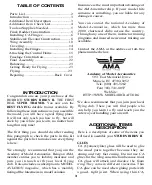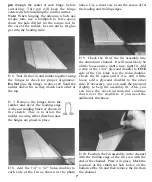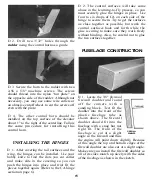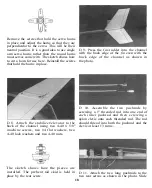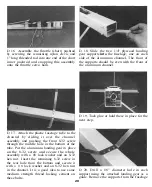
approximately 1" from the edge. The middle
hinge is in the center and the other two hinges
are centered between the outer hinges and the
middle hinge. These hinge locations are not
critical, but proper placement makes it easier
to find the slots after the parts are covered.
Cut the slots for the hinges and test fit the
stabilizer and the elevator together to check for
proper alignment between the two parts.
D 17. Use some thick CA to glue the 1/16"
plywood doubler in place on the stabilizer. This
side is now the bottom of the stabilizer. Use
a ruler to get this piece centered as close as
possible. Use a drafting triangle or carpenter's
square to draw a line perpendicular to the
stabilizer trailing edge and through the center of
the stabilizer to the point where the leading
edges meet.
D 18. Use a pencil and a rubber band to hold
the stabilizer in place as shown in the photo.
Sight down the bottom of the channel and line
the stabilizer up with the channel (using the
line you just drew). When you are satisfied with
the alignment, draw a line down both sides of
the channel on the top of the stabilizer.
D 19. Remove the pencil and rubber band.
With the stabilizer centered over the lines, drill
two 1/8" holes through the stabilizer using the
holes in the channel as a guide. The trailing
edge of the stabilizer should be slightly past
the end of the channel.
D 20. Use a sanding block with some fine
sandpaper to round off the leading edges,
trailing edge and the tips as you did for the
fin and rudder. Also sand the top and bottom
surfaces smooth. This completes the basic
assembly of the stabilizer and elevator. The
control horn and the hinges will be installed
after the tail is covered.
9



